
The fifth
annual Naatyotsavam 2008 - A festival par excellence
- Pratiba
Raman, Chennai
e-mail: pratibaraman@gmail.com
March 25,
2008
It is definitely
not an exaggeration to call it the best of festivals in the city. The temple
ambience always establishes an intimacy with the performers and audience.
It was a festival with a difference - no long, prepped welcome speeches,
no chief guests or guests of honour, and no vote of thanks to eat into
your time. The fifth annual Naatyotsavam at Sri Varasiddhi Vinayaka temple
at Besant Nagar, Chennai, saw performances of eminent Bharatanaatyam professionals,
and the venue was packed with connoisseurs, who enjoyed both the sessions.
The organisers' discipline was reflected in the punctuality of all performances
– very much unlike a plethora of sabha festivals conducted very often.
From the list of nearly twenty artistes who performed during this ten-day
Naatyotsavam 2008, the majority was from the Dhananjayans' Bharatakalanjali,
and the rest were Kalakshetra graduates. The standard and calibre of the
performers were nothing short of being exemplary. This festival coincided
with the leap year birthday celebrations of the legendary Rukmini Devi
Arundale, making it as grand.
I have to confess
my absence on some of the days; hence this is a compilation of views from
some of the knowledgeable people from the audience. Their honest inputs
have helped me tremendously in preparing this report.
Feb 28,
2008
ANUSHA &
NARENDRA KUMAR: The couple kickstarted the festival with great vigour,
while paying obeisance to 'Aaananda Nartana Ganapathy,' a beautiful dance
composition by Anita Shanmuganathan (also providing impeccable nattuvangam)
in the true traditions of their gurus, the Dhananjayans. Dr. Balamuralikrishna's
"amma aananda daayini" in Gambheeranaattai, choreographed by the couple
themselves, was an outstanding piece of work with imaginative narration,
accentuated by both their body movements and facial expressions. While
Anusha has the best of her guru Shanta Dhananjayan’s perfect 'anga suddham'
and Dhananjayans’s mukhaja abhinaya, Narendra Kumar excelled in body postures,
but lacked in 'abhinaya.'
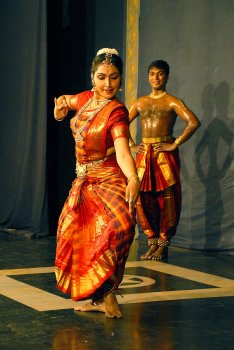 Anusha & Narendra Kumar
Anusha & Narendra Kumar
|
 Manjari Chandrasekar
Manjari Chandrasekar
|
The concluding
number 'pibare raamarasam' of Sadasiva Brahmendra was filled with serenity,
evoking a 'bhakti bhaava.' The audience found themselves in a pensive mood.
The singer
Girish Menon did justice to his role challenging the performers equally.
Yet with added concentration on sruti alignment, his scintillating voice
will par excellence. Sudhaman on mridangam, gave a spirited effect
to the movements and emotions, though its audibility was more than necessary.
Flautist Devaraj was very pleasant.
MANJARI CHANDRASEKHAR:
Her performance was a connoisseur's delight. Her guru/father Prof. C V
Chandrashekar wielded the cymbals with measured beats. Only a person of
his calibre could handle such slow and evocative Swarajathi in Yadukulakambodi
of the Tanjore quartet. With measured precision both in 'abhinaya'
and 'angasuddham,' Manjari proved herself as a complete and competent artiste.
In the jathis
of her varnam (Yedukulakambodhi Swarajathi on Brihadeeshwara), she combined
her adavus and reconstructed them into movements that were unique, yet
within our traditional framework. The Tamizh literature "kurumthogai" failed
to suit the voice of Prof. CVC. The use of Hindustani raagas (Gunkali &
Megh) too did not gel well with old Tamilzh Sangam literature. Aahaarya
abhinaya is also part of theatre art, and Manjari’s makeup could have been
better to makeup for her expressions.
Feb 29,
2008
LAVANYA RAGHURAMAN
had stalwarts as her accompanists, including her guru Shanta doing nattuvangam,
which lifted her performance to a sublime level. Preethi Mahesh's
resonant voice blended itself to beautiful raagas like Sankarabharanam,
the main number of the evening (Athimoham konden). Lavanya was expressive,
musical and rhythmic, yet she could have improved on her postures, especially
the 'ardhamandala.' Simple and elegant was her Thillana of Veena Krishnamachari
in praise of Rukmini Devi, which proved to be a befitting finale, since
the day marked the legend's leap year birthday (104th). It was appropriate
of Lavanya to perform this number as a tribute to her.
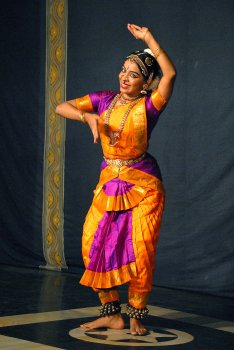 Lavanya Raghuraman
Lavanya Raghuraman
|
 Tulsi Badrinath
Tulsi Badrinath
|
Following Lavanya
the same day was TULSI BADRINATH, one of the senior-most disciples of the
Dhananjayans. From a shaky start with "Gayiye Ganapathaim" (Tulsidas Bhaajan),
she moved on to Nrityopahaaram on Sri Krishna, an elaborate dance praising
the Lord - a very beautiful number which captured the hearts of all in
the audience. But Tulsi looked tensed and her performance lacked technical
correctness (which her school is known for). Araimandi was also missing.
Ambujam Krishna's lullaby song was lucid with precise hand gestures and
abhinaya. Nrittangahaara (a new term for Thillana) in Suratti (Mysore
Vasudevachar) fell flat due to her weak stamina.
March 1,
2008
MAYA VINAYAN's
enchanting Mohiniaattam was one-of-its-kind amidst other Bharatanaatyam
performances. She could bring out the laasya aspect of the idiom
through her graceful adavu patterns. Her selection of items enlisted
refreshingly new compositions – invocation on Ganapathy, Varnam on Raama
and the Abhinaya Padam depicting the Srikrishna Sudhama story. Maya is
very expressive and communicative in her execution of aangika abhinaya,
but her hasta mudras were not held properly, and failed to synchronise
with the lyrics. Yet, she is certainly a promise of the future.
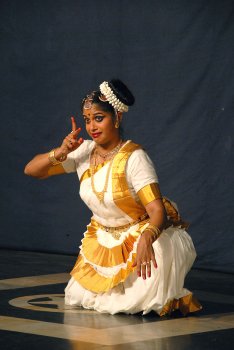 Maya Vinayan
Maya Vinayan
|
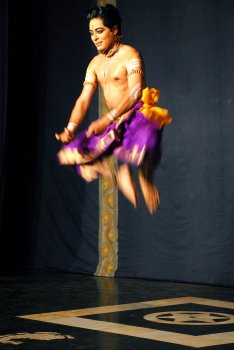 Suryanarayana Murthy
Suryanarayana Murthy
|
SURYANARAYANA
MURTHY drew loud applause for his energetic execution of complicated jathis
composed and choreographed by his gurus, the Dhananjayans. The Nrithyopahaaram
on Varasiddhi Vinayaka of Besant Nagar by Vidwan T V Gopalakrishnan was
very appropriate for the occasion though he did partial justice to a masterpiece
of his gurus' creation. There were times when he seemed lost with vague
expressions. His exaggerated effort in stamping his feet (thattu)
marred the beauty of neat execution. He needs to sober down a bit to get
the sublime satvika abhinaya of his mentors.
March 2,
2008
GOPUKIRAN:
A young artiste who has secured a distinction in his Post Graduate program
in Bharatanaatyam from the Madras University, he is yet another promise
of the future from the portals of Bharatakalanjali. He has the agility
and ability to impress the connoisseurs of Chennai. Ganesha Stotram, composed
by mridangam maestro Karaikudi Krishnamurthy in Hindola raaga, was a good
start, and the audience was glued to their seats. Following that was Kharaharapriya
Padavarnam set as a Nrityopahaaram that sailed smoothly for a full 45 minutes.
A fixed smile on his face often belied the right kind of expression, while
the audience was left wondering whether he was depicting anger or sringara.
He has a good sense of rhythm and speed with a fine finish in his adavus.
Ashtapadi "Vadasiyadi kinchidapi" in Sindhubhairavi lacked sensitivity
and the pretended agony of a sringara nayaka needs to be established by
experience. The Nrittangahaara in Charukesi composed and choreographed
by Gopukiran with its brilliant 'nritta' passage brought the house down.
Rajesh's singing and Kartik's mridangam coupled with his enthusiastic performance
made for a gripping climax.
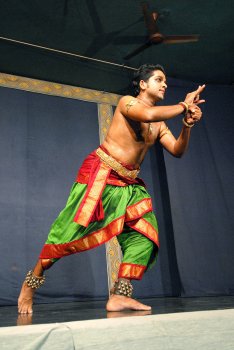 Gopukiran
Gopukiran
|
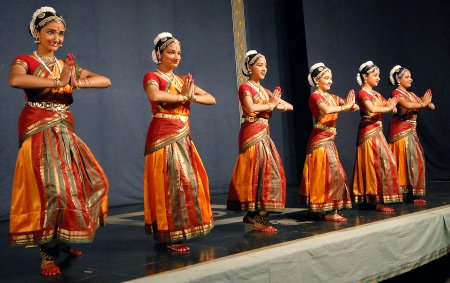 Radhika Shurjit Group
Radhika Shurjit Group
|
RADHIKA SHURJIT,
the seniormost alumni of Bharatakalanjali presented a group of well-trained
youngsters, and she alone did an abhinaya piece where the nayika reminds
Muruga of her happy days with Him, accusing Him of flirting with another
maiden. Krishnakshi Sarma presented a Varnam of Ponnaih Pillai in Sankarabharanam.
She stole the show with her stunning beauty and excellent performance of
both nritta and abhinaya. It is often a wonder why such good Bharatanaatyam
dancers are not often seen or encouraged by the sabhas / cultural organizations.
A little one named Jyotsna Ramesh has all the requirements for an excellent
Bharatanaatyam artiste, with an amazing potential essayed by her in the
popular song "maadumeikkum kanna." On the whole, it was a well co-ordinated
presentation, enjoyed by all.
March 3,
2008
PRITVIJA BALAGOPAL,
a postgraduate from Kalakshetra and daughter of Kalakshetra's famous teacher
Balagopal, proved herself to be one of the best Bharatanaatyam artistes.
True to the Kalakshetra tradition, it was a simple, straight Maargam repertoire.
As guru Dhananjayan remarked at the end of her performance, "neat execution
and beautiful presentation imbibing the great qualities of her father Balagopalan."
She kept the audience in rapt attention.
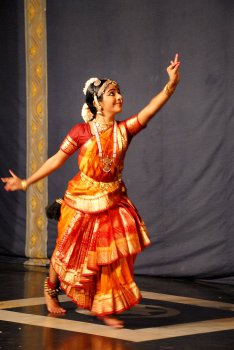 Prithvija Balagopal
Prithvija Balagopal
|
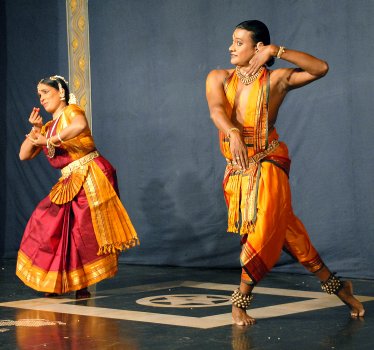 Pramila & Hariharan
Pramila & Hariharan
|
HARIHARAN and
PRAMILA's performance, in contrast to Prithvija's, was a firework of complicated
and unduly long jathis, losing the serenity of a solo Bharatanaatyam performance.
One could feel and understand the hard work they have put in, taking this
rare opportunity to impress the best rasikas of the city. Pramila executed
her adavus with accurate precision and finish. Hariharan impressed
the audience with his aangika abhinaya, and exuberance of a manly stature
and gait. His accompanying musicians were a bit strident, especially the
mridangam.
March 4,
2008
VIJNARANI
VASUDEVAN is yet another dancer to be watched. It was announced that
she won the first prize in an all India competition for Bharatanaatyam
and she justified her achievement with a very beautiful performance. The
full credit of staging that was given to Divya Sivasundar who very ably
conducted the performance. The choreography for the Mayamaalavagowla raaga
Padavarnam of Papanasam Sivan is a masterpiece of the Dhananjayans and
Vijna's performing it with such grace and precision made several heads
turn. Vanathy's expressive singing of "Vagalaadi bodhanalaku" reflected
in the beautiful countenance of Vijna with matured and sensitive abhinaya.
Her Desh Thillana of Ranganayaki Jayaraman, choreographed by Shanta Dhananjayan,
was a 'piece de resistance.' Vijna is truly a promise of the future.
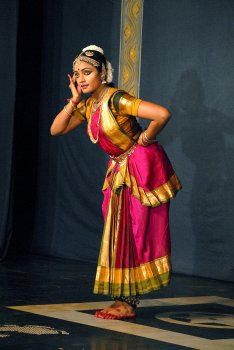 Vijnarani Vasudevan
Vijnarani Vasudevan
|
 Gayathri Balagurunathan
Gayathri Balagurunathan
|
GAYATRI BALAGURUNATHAN,
daughter and disciple of late guru Krishnaveni of Kalakshetra, was a delight
to watch, almost resembling her mother’s impeccable performance. The opening
dance Natarajanjali firmly established her grip over movement and rhythm
and when moved on to that ever enchanting Varnam of Swathi in Todi raga,
"Daani saamajendra gaamini," stood as an acid test to Gayatri's consummate
understanding and involvement in her profession. She seems to be creative
as well as steadfast in basic techniques imbibed from her mentor. The Periyalwar
Pasuram, the last number she learned from her mother, was performed with
a passion and sentiment attached.
March 5,
2008
SHAFEEKUDEEN
BK was a chip off the old block, imbibing a great deal from his master/mentor
Dhananjayan. Good body postures, clean hastas, perfect rhythm and clarity
in steps like didhitei or kiratakadharikitathom. The Nrityopahaaram (Violinist
Seetharama Sharma's music composition in Dharmavathi raagam) was met with
superb choreography by Shanta Dhananjayan. This is one the best of Varnams
on Shiva ever choreographed by any of the Natyacharyas. Shafeekudeen did
full justice to this exquisite interpretation of myriads of stories on
Shiva. He certainly needs to improve on his histrionics - using his
eyes, eyebrows, chin etc.
 Shafeekudeen
Shafeekudeen
|
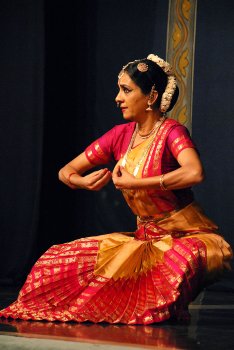 Shobana Balachander
Shobana Balachander
|
SHOBANA BALACHANDER,
one of the famous trio sisters (Radhika, Gayatri and Shobana), was neat,
clean and matured in her abhinaya. Rajkumar Bharati's new invocation song
was good, but Nrityapriya did not take off well, probably due to the musical
monotony or loose choreography. Maybe the audience was tempted to compare
the previous Shiva Varnam choreographed and conducted with such confidence
and grace by Shanta Dhananjayan, to this one. Shobana needs to rehearse
and perform a couple of times more to tie the loose ends. The heroine recollects
her past days with her husband in a Kshetragna Padam in Anandabhairavi,
saw glimpses of Shobhana's ability to emote, yet there is a trace of unnatural
stances and gesture, which belie her groomed technique. The choreography
for the Kanada Thillana of Lalgudi Jayaraman was indeed a good attempt
by Shobana, but the music composition itself failed to match his other
Tillanas. Neela Sukanya's nattuvangam and Vanathy Raghuraman's singing
were very good. Rameshbabu's mridangam drowned the orchestra and
an audio balancing before the show could have enhanced the 'Pakkamelam.'
March 6,
2008
SHIJIT NAMBIAR
secured a distinction in his Post Graduate diploma from Kalakshetra. He
is very vibrant and energetic. Unlike his alma mater, the invocation becomes
a major number taking away the importance of the central piece like Varnam
or Swarajathi. Many dancers resort to an elaborate opening, distracting
and deviating from the significance of an opening invocatory item.
Chokkeswar Kouthuvam was very well performed with intricate choreographic
nuances by G Narendra. The opening number seemed to assume greater
significance, but with not much substance to offer, it became a combination
of physical activity. This trend could be avoided. Shijit has great potential,
grace and well-trained body. The extract from Kumarasambhavam offers nothing
special to communicate. This composition is an array of small beautifully
set theermaanams. Finally it was the simple bhajan that gave an emotional
slant to the audience. The virutham on Shiva was excellently rendered
by Deepu Nair and Shijit brought forward his hidden histrionics.
Sheejith Krishna did nattuvangam with clarity and dexterity. Ramesh
Babu is an asset to any dancer, following the dancers with meticulous concentration.
But overly decorated frills distract audience from the main artiste.
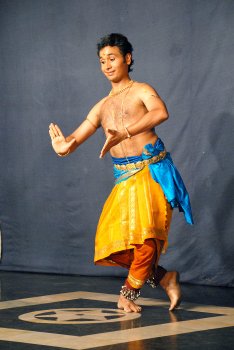 Shijit Nambiar
Shijit Nambiar
|
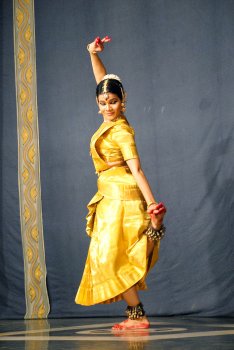 Divya Sivasundar
Divya Sivasundar
|
DIVYA SIVASUNDAR,
accompanied on nattuvangam by Sreelatha Vinod, made an indelible impression
on the rasikas with an exquisite Padavaranm "Sumasaayaka" in Karnatakakapi
by Swathi Tirunal. This very slow and evocative musical marvel lends
itself for a technical virtuosity of a Bharatanaatyam dancer and Divya
justified her merit in every aspect of the technique. Eswar Ramakrishnan's
singing provided good support. After this elevating experience, no
items following this could have had any impact. Her golden costume did
not match the quality of her dance or the aesthetic presentation.
Some people in the audience did wonder how her gurus, the Dhananjayans,
could ever allow such a costume to go with such a brilliant performer.
March 7,
2008
PRAMILA RAMESH
is yet another bright star on the horizon, having imbibed the best of Bharatakalanjali
qualities. Well-rehearsed and well-executed adavus and abhinaya; nothing
excess or short in her delineation. The Nrityopahaaram on Sri Rama
is a beautiful piece of music and dance in Kharaharapriya raagam. Though
her araimandi was missing on most occasions, Pramila did impress the audience
with both nritta and nritya. Sasidharan's singing was very harsh. Unwanted
and mismatching frills in the rendering of neraval (improvisation) spoilt
the beautiful voice. Sporadically, he sprang surprises of soothing melody.
(A question
to the Dhananjayans: The Kharaharapriya Varnam was repeated twice in the
programs. When Gopukiran showed the 'shat ripu' (six enemies of men) he
expressed lust towards his opposite sex. But when Pramila did the
same, she also showed lust towards the female, not her opposite sex instead.)
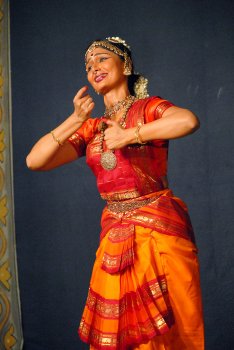 Pramila Ramesh
Pramila Ramesh
|
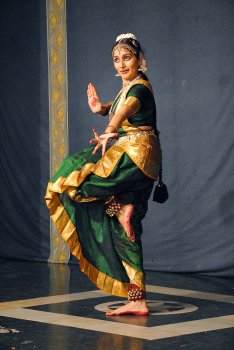 Ganga Thampi
Ganga Thampi
|
GANGA THAMPI started
her presentation with a Pushpaanjali in Neethimathi raaga, followed by
an extract from Kalidasa's Kumarasambhavam, choreographed by Leela Samson
and music by Madhup Mudgal. This did not give much scope for Ganga to exhibit
her potential. She should have chosen a heavy regular Bharatanaatyam repertoire
to bring forth the Kalakshetra technique combined with her own creativity.
This piece was a simple, monotonous description of the marriage procession
of Shiva and Parvathi. Though the Surdas Bhajan gave some space for
her to demonstrate sensitive abhinaya, the following song "Mahadeva Sambho"
did not fit in well for matured abhinaya. The Poorvi Thillana was a refreshing
contrast to the previous, almost similar ragas. But then the tired-looking
Ganga could not do justice to her nritta portions. The required punch
for a Bharatanaatyam repertoire was missing, probably due to the selection
of North Indian raga-based items. The well accomplished and balanced musical
ensemble included Deepu Nair (vocal), Haripadman (nattuvangam), Ramesh
Babu (mridangam), Ananthanarayan (veena), and Muthu Kumar (flute).
March 8,
2008
K P YASODA
bore the typical stamp of the old world charm of Kalakshetra, clubbed with
a spirited utterance of jatis by guru Adyar K Lakshman. Neat execution
of adavus and hastamudras marked the recital. One may raise a question
in the sancharis of "Neeyindamaayam" (Dhanyasi Varnam), "Whether it is
appropriate to depict the childish pranks of Krishna, while a lovelorn
nayika speaks of her adult sringara nayaka and his various amorous deeds.
Yasoda did it in a copy book style."
 K P Yasoda
K P Yasoda
|
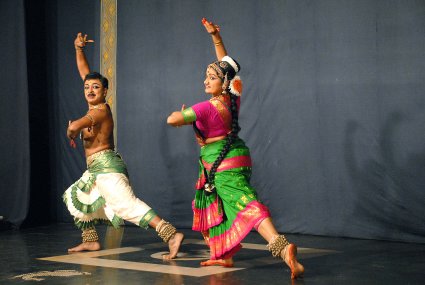 Hemanth Kumar & Vijayalakshmi
Hemanth Kumar & Vijayalakshmi
|
HEMANTH KUMAR
& VIJAYALAKSHMI: A good amalgamation of rustic charm and sophistication
gave a new dimension to the performance of this couple, who were introduced
as "artistes taking this classical art to its roots." They are serving
the rural area of Tamil Nadu , teaching and performing for rural folks.
Hemanth was exuberant, expressive and bubbling with energy like a rural
Koothu artiste, whereas his wife Vijayalakshmi was sober and serene. The
main item, a rare Kanada Varnam in Reetigowla of Vyasaraya jubilantly performed
by Hemanth alone, accompanied by his wife on nattuvangam, was a potpourri
of jumps, leaps and speed. The Ashtapadi "Nindathi chandana" by Vijayalakshmi
brought her alma mater's stamp of dignity and divinity - The Dhananjayans.
Hemanth's creative ability was evident throughout the performance culminating
in Ganesha Pancharatnam. Their accompanying musicians Arun Gopinath (vocal)
with excellent training and mellifluous voice captivated the audience.
Mridangam by Kalamandalam Anil Kumar was an excellent support to the dancers.
Suresh Nambuthiri (violin) and Sankaranaryan (flute) did their job well.
The utsavam
climaxed with a befitting and unparalleled performance by Natyacharya Dhananjayan
himself who left the audience spellbound, making them long for more. The
highlight of the performance was the fact that he was supported on the
vocal by legendary singer from Kalakshetra, MD Ramanathan’s disciple, Prof.
P P Ramakrishnan, Retd Principal, Swathi Thirunal College of Music, Thiruvananthapuram.
(This report
is prepared with inputs from the audience – Guru Girija Chandran, Pavitra
Srinivasan, M H Thyagarajan, Mythili Prakash and Kulathu Iyer to name a
few.)
Pratiba
Raman is a journalist trainee and Bharatanaatyam artiste.
Response from guru VP Dhanjayan
April 3, 2008
This is with reference to Pratiba's
review / report on the 5th Naatyotsavam 08. She has posed a question to
us on the relevance of both man and woman expressing the lust (one of six
enemies of human (shat ripu) toward the same gender, that is a female.
What she means I suppose is that when Gopukiran performed he showed a man's
lust towards opposite gender. The same song when Pramila performed, she
also showed lust towards the same female.
I appreciate Pratiba noticing such
small nuances and bringing to our notice. Actually a solo Bharatanaatyam
performer has no gender discrimination, she or he is neutral when interpreting
a song. When we usually refer to 'lust' it is the men's unreserved urge
that is predominantly talked about or expressed. So when I choreographed
"Raama Varnam" as a Nrityopahaaram, I was performing it more than Shanta.
So whatever I have been delineating, that passed on to our students, not
taking into account their male, female difference. But there is nothing
wrong in a woman as performer, gesticulating "lust" towards woman. I hope
I made it clear.
- Naatyaachaarya VP Dhananjayan
|

